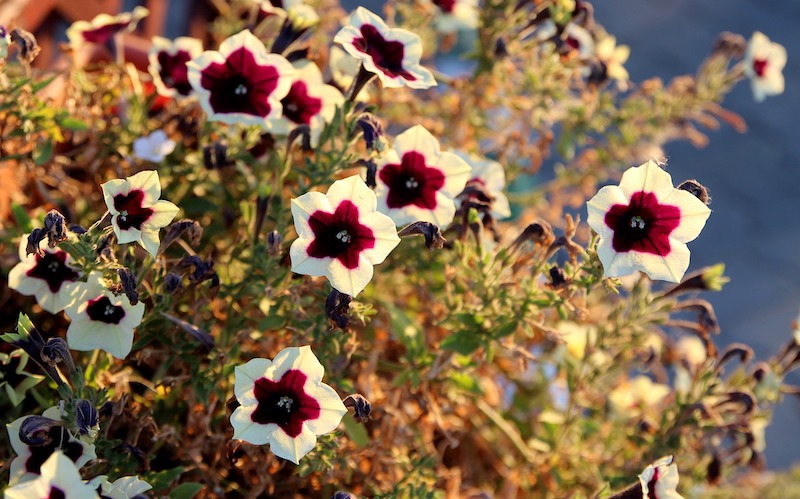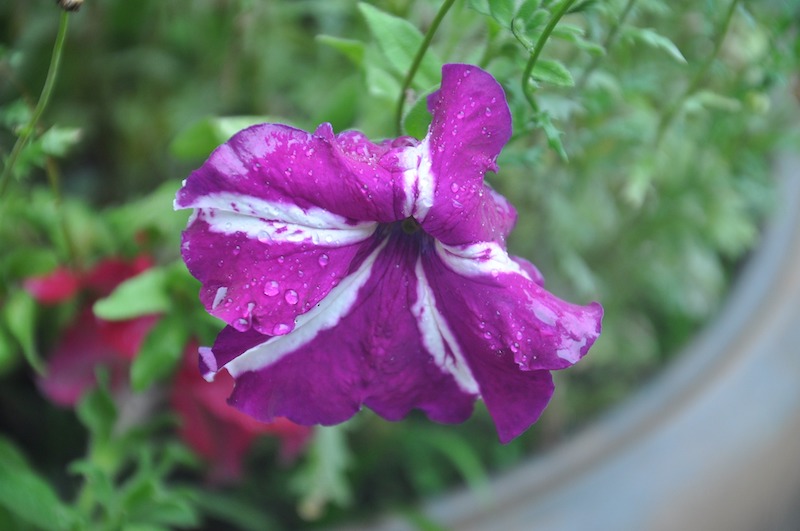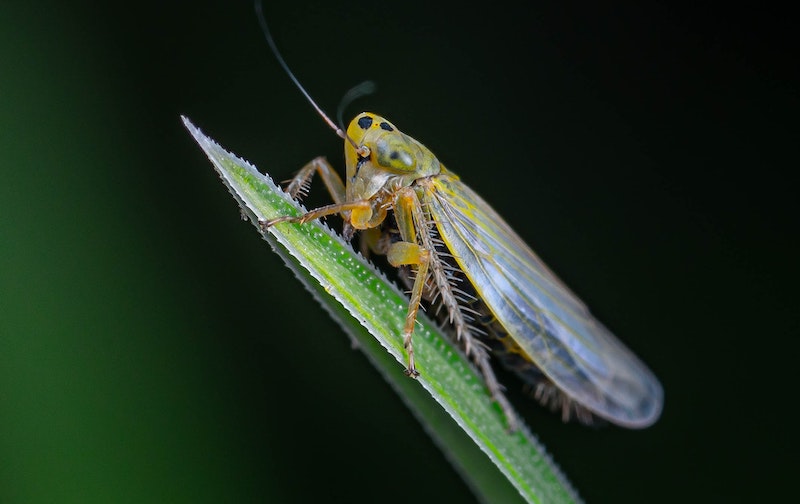The diseases that afflict Petunias may seem like a long and scary list. Many of the diseases are fungal or bacterial and not necessarily species specific. By not controlling the original outbreak, the pathogen could spread to other plants in your garden. Fungal diseases such as botrytis blight, powdery mildew, and crown rot cause parts of the plant to die and rot.
Bacterial types of infections such as bacterial leaf spot, aster yellows, and some types of fasciation are easily spread in overcrowded plantings. Viruses such as impatiens necrotic spot virus and tobacco mosaic virus are spread by insect vectors or humans with non-sterilized hands or tools, especially in a greenhouse setting where a large monoculture of plants are grown.

Powdery Mildew
Powdery mildew is a fungal disease that most often occurs toward the end of summer when the daytime temperatures are warm with much cooler and drier nighttime temperatures. Although the majority of powdery mildew fungi are plant specific, many are not and will infect other plants when left unchecked. Young plants and annuals will have more severe reactions to the pathogen and are more likely to die from the fungus than mature plants, perennials, and shrubs.
Identifying Powdery Mildew
A white or gray powdery film on foliage is the number one sign that a plant is infected. The fungus can distort leaf growth and is easily transmitted to other parts of the plant by overhead watering or wind.
Treating Powdery Mildew
The number one way to treat powdery mildew is the prompt removal and disposal of any affected stems and foliage. This keeps the spreading of the fungus to a minimum. Fungicides are available for powdery mildew and should indicate which plant they can be used on. Fungicides will only protect parts of the plant that are not already infected and should only be used as a last resort. Treating Petunias for powdery mildew early in the season may be worth the time and effort, while Petunias infected late in the summer may just need to be disposed of instead.
The best practices to prevent powdery mildew are to use clean potting soil and containers when planting or repotting Petunias. Clean any clippers with a diluted bleach solution that has been used to remove parts of infected plants. Avoid overhead fertilizing or overfertilizing plants. Buy plant cultivars resistant to powdery mildew. Allow plenty of air circulation between plants.

Botrytis Blight
Botrytis is also known by the more common name of gray mold. This fungal disease occurs in warm, humid conditions and can rapidly kill off young plants. The black or gray spores invade damaged tissue on the plant, form lesions where the spores grow, and rapidly spread into the undamaged areas of stems, leaves, and flowers. Plant debris that has fallen off the plant will harbor spores and should be removed as soon as possible. Botrytis is not plant specific and transfers to other species easily.
Identifying Botrytis Blight
Botrytis appears on damaged or spent plant material first. Dark spots that quickly are covered in dark gray or black spores cause death to the infected portion of the plant. If not removed, the spores invade healthy tissue and eventually can kill plants.
Treating Botrytis Blight
Mechanical methods of treatment are the most successful. Immediately remove any affected parts still on the plant or that have fallen on the soil around the plant and dispose of them in the trash. Do not compost infected plant material in your home compost pile. Fungicides may be successful in protecting parts of the plant that have not been infected. A fungicide must be listed for use on Petunias. Apply according to the manufacturer's instructions. Repeated spraying throughout the growing season will be required.
The best way to prevent Botrytis from being a problem in your garden is by practicing good garden hygiene. Avoid overhead watering, which can spread spores and cause the foliage to remain wet for long periods. Deadhead and remove any spent flowers in a timely manner. Space plants so that good air circulation and light penetration are possible.
Phytophthora Crown Rot
Phytophthora parasitica is the scientific name for crown rot in Petunias. This is a fungal disease that causes roots and the growing crown to rot, resulting in eventual plant death. Although the Phytophthora fungus is plant specific, each of the strains is recognizable by similar traits. Phytophthora can occur at any time of the year with young or mature plants being affected equally.
Identifying Phytophthora Crown Rot
Infected plants may have stunted growth or discoloration on the stems, particularly near the growing crown. In general, plants will gradually decline in vigor and blooming with no other obvious reason. Infected roots may be colored a reddish brown instead of a healthy creamy white.
Treating Phytophthora Crown Rot
Few chemical controls for Phytophthora on plants exist. Mechanical treatment is the primary way to control an outbreak. Because Phytophthora remains in the soil for long periods, make sure to use new, sterilized potting mix for potted plants every year, even if you don’t have infected plants. Petunias grown in the garden as a bedding plant require rotation from one location to another from year to year. This practice will lower the likelihood of infection. Do not plant Petunias in an area that has been infected in the past. Remove any infected plants and some surrounding soil as quickly as possible after diagnosing an outbreak of Phytophthora. Dispose of the plants by throwing them in the trash or burning. Do not attempt to compost infected plant material. Ensure that growing areas or containers are well draining year-round.
Bacterial Leaf Spot
Bacterial leaf spot, scientifically known as Xanthomonas campestris, most often affects Petunias in an enclosed atmosphere such as a greenhouse or even a sheltered outdoor location. There are no chemical controls for this bacteria and often the only remedy is the removal of infected plants as quickly after diagnosis as possible. The bacteria spreads by water droplets when plants are moved from one spot to another or are dripped on from hanging baskets overhead. High humidity with little air circulation is the perfect climate for bacterial leaf spot.
Identifying Bacterial Leaf Spot
Brown spots on the foliage that appear to be soaked by water are the number one clue that your Petunia is infected with leaf spot. Stems may also be damaged and may have brown spots or bands on them. Affected plants may have stunted growth and an early demise.
Treating Bacterial Leaf Spot
Removing and disposing of affected plants is the primary control for this disease. Do not handle plants that are wet and infected, as this will spread the bacteria. Increase the air circulation and light penetration around plants with proper spacing and the use of fans or open vents in a greenhouse environment.
Aster Yellows
A bacterial infection that is transferred via an insect host is a vectored disease. Aster Yellows is vectored by various species of leafhoppers. The leafhopper feeds on parts of the plant and transmits Aster Yellows seemingly out of nowhere. The pathogen for Aster Yellows is actually a phytoplasma, which is smaller than a bacteria and larger than a virus.

Identifying Aster Yellows
Plants that begin to become leggy and spindly and lose color in their stems, flowers, and foliage may be infected with Aster Yellows. The flowers become distorted and elongated in appearance. Clumps of spindly, yellow growth may develop at the base of the plant. Cool, wet weather speeds the spread of Aster Yellows. The leafhopper vector and the phytoplasma are not as mobile during dry, hot weather.
Treating Aster Yellows
No chemical controls are available for this bacteria infection. The means of control are mechanical and preventative. Remove any plant that has been diagnosed with Aster Yellows and monitor surrounding plants. Do not compost infected plant material. Clear weeds from around planting areas or the deck and patio where you are growing potted Petunias. The leafhopper uses weeds and other overgrown plants as shelter.
Fasciation
Fasciation of plants can result from bacterial or viral infections. It is also sometimes a result of genetic mutations in the plant and will not damage any other plant around it. Fasciation causes distortions in the growth patterns of stems, flowers, and foliage. Stems can appear to be flattened or elongated. Genetic fasciation will cause deformities of flowers such as two stems developing as one with flattened or double-headed flowers.
Identifying Fasciaton
Bacterial fasciation occurs in a portion of a plant that has been injured. Twisted or swollen stems may develop. Flattening of stems and flowers is also a common symptom. Any unusual growths that are not attributed to another disease or pest could be fasciation. Petunias may exhibit shortened stems that have dense clusters of flowers. These flowers will not open properly and may encourage other diseases that thrive when plants are grown too close together.
Treating Fasciation
Fasciation is only treated by mechanical and preventative means. Remove any parts of the plant that appear diseased or are growing abnormally. Do not take cuttings from plant material that is visibly fasciated. There is no way to tell if the fasciation is caused by genetics or a pathogen.
Impatiens Necrotic Spot
Necrotic Spot on Petunias is more likely to occur when the plants are grown in a high-humidity atmosphere such as a greenhouse. This virus affects the foliage, eventually reducing the photosynthesis ability of the plants and ultimately resulting in death. This disease is a virus and may not be immediately visible when bringing new plants home from the nursery.
Identifying Impatiens Necrotic Spot
Foliage will show yellow, white, or brown spots that may be in the center of the leaf or extend to the margins. The spot is dry unlike in bacterial infections, where affected areas have a watery look to them. Leaves may become more distorted before dropping from the plant.
Treating Impatiens Necrotic Spot
INSV is transferred between plants by flower thrips. Controls for thrips are generally cultural as well as some chemical sprays for larger outbreaks. The thrips (and therefore the virus) thrive in overcrowded conditions with high heat, humidity, and low air circulation. Remove any plants that show signs of infection. Disinfect tools, pots, and growing benches when preparing for a new growing season inside the greenhouse. Always clean and disinfect outdoor pots and growing containers, and use fresh potting mix when potting up Petunias.
Tobacco Mosaic Virus
Petunias can be infected by many of the same viruses that plague tomato, potato, and tobacco crops because it is also a member of the Night Shade, or Solanaceae, family. The most common virus in this plant family is Tobacco Mosaic Virus. It is a very contagious virus that easily moves between plants, stays viable on surfaces such as potting benches for a very long time, and is transmitted readily by the nicotine on smokers' fingers.
Identifying Tobacco Mosaic Virus
Tobacco Mosaic Virus is easily recognizable by yellow and green patterning on the leaves or a deformed shape with yellowing along the veins. The flowers are typically deformed and may have unusual coloring or streaking. Plants appear to be stunted and in need of fertilizing or watering.
Treating Tobacco Mosaic Virus
Cultural methods are the only means to treat or prevent Tobacco Mosaic Virus from spreading. Clean all greenhouse or potting shed surfaces thoroughly with a diluted bleach solution. Clean all pots and tools regularly and after pruning or treating diseased plants. Inspect and monitor any new plants brought into the greenhouse or garden for signs of infection. Smokers will need to wash their hands thoroughly before handling plants.
Petunia Disease Chart
|
Disease |
Identifying |
Treating |
|
Botrytis Blight |
Gray or black mold on leaves, stems or flower buds |
Discard affected plant material |
|
Powdery Mildew |
White or gray powdery film on foliage and stems |
Remove affected plant material, fungicides prevent spreading to unaffected parts |
|
Phytophthora Crown Rot |
Darkening of stems at the growing point, brown or reddish colored roots |
Remove affected plants Ensure well-draining soil and proper growing conditions |
|
Bacterial Leaf Spot |
Watery brown spots of foliage, stunted plant growth |
Remove affected leaves and dispose Provide air circulation and proper spacing of plants |
|
Aster Yellows |
Yellowing and distortion of foliage, stems and flowers |
Remove weeds or overgrown plants that are shelter for the leafhopper |
|
Fasciation |
Distorted stem and leaf growth, flattening and ingrowing of multiple flower stems |
Discard plant and do not take cuttings of it |
|
Impatiens Necrotic Spot |
Brown spots on leaves that are dry, stunted overall growth |
Dispose of plant |
|
Tobacco Mosaic Virus |
Yellow and green mosaic patterning on leaves and distorted growth |
Disinfect all tools, dispose of plant |
Sources:
"Petunia—Petunia x hybrida, Family Solanaceae (Nightshade family)." University of California Integrated Pest Management. ipm.ucanr.edu.
 |
Author Robbin Small - Published 4-11-2023 |
